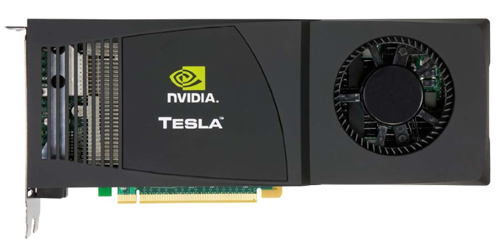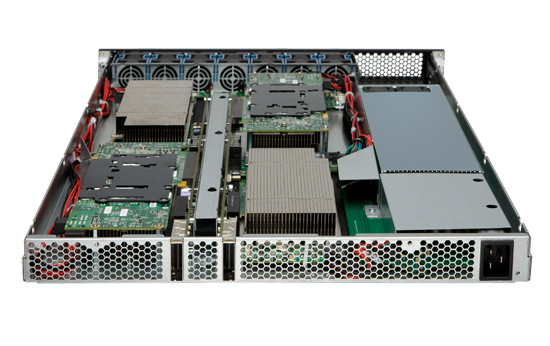NVIDIA's Fermi: Architected for Tesla, 3 Billion Transistors in 2010
by Anand Lal Shimpi on September 30, 2009 12:00 AM EST- Posted in
- GPUs
A Different Sort of Launch
Fermi will support DirectX 11 and NVIDIA believes it'll be faster than the Radeon HD 5870 in 3D games. With 3 billion transistors, it had better be. But that's the extent of what NVIDIA is willing to talk about with regards to Fermi as a gaming GPU. Sorry folks, today's launch is targeted entirely at Tesla.

A GeForce GTX 280 with 4GB of memory is the foundation for the Tesla C1060 cards
Tesla is NVIDIA's High Performance Computing (HPC) business. NVIDIA takes its consumer GPUs, equips them with a ton of memory, and sells them in personal or datacenter supercomputers called Tesla supercomputers or computing clusters. If you have an application that can run well on a GPU, the upside is tremendous.

Four of those C1060 cards in a 1U chassis make the Tesla S1070. PCIe connects the S1070 to the host server.
NVIDIA loves to cite examples of where algorithms ported to GPUs work so much better than CPUs. One such example is a seismic processing application that HESS found ran very well on NVIDIA GPUs. It migrated a cluster of 2000 servers to 32 Tesla S1070s, bringing total costs down from $8M to $400K, and total power from 1200kW down to 45kW.
| HESS Seismic Processing Example | Tesla | CPU |
| Performance | 1 | 1 |
| # of Machines | 32 Tesla S1070s | 2000 x86 servers |
| Total Cost | ~$400K | ~$8M |
| Total Power | 45kW | 1200kW |
Obviously this doesn't include the servers needed to drive the Teslas, but presumably that's not a significant cost. Either way the potential is there, it's just a matter of how many similar applications exist in the world.
According to NVIDIA, there are many more cases like this in the market. The table below shows what NVIDIA believes is the total available market in the next 18 months for these various HPC segments:
| Processor | Seismic | Supercomputing | Universities | Defence | Finance |
| GPU TAM | $300M | $200M | $150M | $250M | $230M |
These figures were calculated by looking at the algorithms used in each segment, the number of Hess-like Tesla installations that can be done, and the current budget for non-GPU based computing in those markets. If NVIDIA met its goals here, the Tesla business could be bigger than the GeForce one. There's just one problem:
As you'll soon see, many of the architectural features of Fermi are targeted specifically for Tesla markets. The same could be said about GT200, albeit to a lesser degree. Yet Tesla accounted for less than 1.3% of NVIDIA's total revenue last quarter.
Given these numbers it looks like NVIDIA is building GPUs for a world that doesn't exist. NVIDIA doesn't agree.
The Evolution of GPU Computing
When matched with the right algorithms and programming efforts, GPU computing can provide some real speedups. Much of Fermi's architecture is designed to improve performance in these HPC and other GPU compute applications.
Ever since G80, NVIDIA has been on this path to bring GPU computing to reality. I rarely get the opportunity to get a non-marketing answer out of NVIDIA, but in talking to Jonah Alben (VP of GPU Engineering) I had an unusually frank discussion.
From the outside, G80 looks to be a GPU architected for compute. Internally, NVIDIA viewed it as an opportunistic way to enable more general purpose computing on its GPUs. The transition to a unified shader architecture gave NVIDIA the chance to, relatively easily, turn G80 into more than just a GPU. NVIDIA viewed GPU computing as a future strength for the company, so G80 led a dual life. Awesome graphics chip by day, the foundation for CUDA by night.
Remember that G80 was hashed out back in 2002 - 2003. NVIDIA had some ideas of where it wanted to take GPU computing, but it wasn't until G80 hit that customers started providing feedback that ultimately shaped the way GT200 and Fermi turned out.
One key example was support for double precision floating point. The feature wasn't added until GT200 and even then, it was only added based on computing customer feedback from G80. Fermi kicks double precision performance up another notch as it now executes FP64 ops at half of its FP32 rate (more on this later).
While G80 and GT200 were still primarily graphics chips, NVIDIA views Fermi as a processor that makes compute just as serious as graphics. NVIDIA believes it's on a different course, at least for the short term, than AMD. And you'll see this in many of the architectural features of Fermi.










415 Comments
View All Comments
palladium - Monday, October 5, 2009 - link
Not quite:http://www.dailytech.com/article.aspx?newsid=16410">http://www.dailytech.com/article.aspx?newsid=16410
Scroll down halfway thru the comments. He re-registered as SilicconDoc and barks about his hatred for red roosters (in an Apple-related article!)
johnsonx - Monday, October 5, 2009 - link
that looks more like someone mocking him- Sunday, October 4, 2009 - link
According to this very link http://www.anandtech.com/video/showdoc.aspx?i=3573...">http://www.anandtech.com/video/showdoc.aspx?i=3573... AMD already presented a WORKING SILICON at Computex roughly 4 months ago on June 3rd. So it took roughly 4 and a half months to prepare drivers, infrastructure and mass production to have enoough for the start of Windows 7 and DX11. However, Nvidia wasnt even talking about W7 and DX11 so late Q1 2010 or even later becomes more realistic than december. But there are much more questions ahead: What pricepoint, Clockrates and TDP. My impression is that Nvidia has no clue about this questions and the more I watch this development, the more Fermi resembles to the Voodoo5 Chip and the V6000 card which never made into the market because of its much to high TDP.silverblue - Sunday, October 4, 2009 - link
Nah, I expect nVidia to do everything they can to get this into retail channels because it's the culmination of a lot of hard work. I also expect it to be a monster, but I'm still curious as to how they're going to sort out mainstream options due to their top-down philosophy.That's not to say ATI's idea of a mid-range card that scales up and down doesn't have its flaws, but with both the 4800 and 5800 series, there's been a card out at the start with a bona fide GPU with nothing disabled (4850, and now 5870), along with a cheaper counterpart with slower RAM and a slightly handicapped core (4830/5850). Higher spec single GPU versions will most likely just benefit from more and/or faster RAM and/or a higher core clock, but the architecture of the core itself will probably be unchanged - can nVidia afford to release a competing version of Fermi without disabling parts of the core? If it's as powerful as we're lead to believe, it will certainly warrant a higher price tag than the 5870.
Ahmed0 - Saturday, October 3, 2009 - link
Nvidia wants it to be the jack of all trades. However, they are risking with being an overpriced master of none. Thats probably the reason they give their cards more and more gimmicks to play with each year. They are hoping that the cards value will be greater than the sum of its parts. And that might even be a successful strategy to some extent. In a consumerist world, reputation is everything.They might start overdoing it at some point though.
Its like mobile phones nowadays. You really dont need to have a radio, an mp3-player, a camera nor other such extras in it (in fact, my phone isnt able to do anything but call and send messages). But unless you have these features, you arent considered as competition. It gives you the opportunity to call your product "vastly superior" even though from a usability standpoint it isnt.
SymphonyX7 - Saturday, October 3, 2009 - link
Ahh... I see where you're coming from. I've had many classmates who've asked me what laptop to buy and they're always so giddy when they see laptops with the "Geforce" sticker and say they want it cause they want some casual gaming. Yes, even if the GPU is a Geforce 9100M. I recommended them laptop using AMD's Puma platform and many of them ask if that's a good choice (unfortunately here, only the Macbook has a 9400M GPU and it's still outside many of my classmates' budgets). Seems like brand awareness of Nvidia amongst many consumers is still much better than AMD/ATI's. So it's an issue of clever branding then?Lifted - Saturday, October 3, 2009 - link
A little late for any meaningful discussion over here as AT let the trolls go for 40 or so pages. I doubt many people can be arsed to sort through it now, so you'd be better off going to a forum for a real discussion of Fermi.neomocos - Saturday, October 3, 2009 - link
if you missed it then here you go ... happy day for all of us :quote from comment posted on page 37 by Pastuch
" Below is an email I got from Anand. Thanks so much for this wonderful site.
-------------------------------------------------------------------
Thank you for your email. SiliconDoc has been banned and we're accelerating the rollout of our new comments rating/reporting system as a result of him and a few other bad apples lately.
A- "
james jwb - Saturday, October 3, 2009 - link
Some may enjoy it, but this unusual freedom that blatant trolls using aggressive, rude language are getting lately is making a mockery of this site.I don't mind it going on for a while, even 20 pages tbh, it is funny, but at some point i'd like to see a message from Gary saying, "K, SiliconDoc, we've laughed enough at your drivel, tchau, banned! :)"
That's what i want to see after reading through 380 bloody comments, not that he's pretty much gotten away with it. And if he has finally been banned, i'd actually love to know about it in the comments section.
/Rant over.
Gary Key - Monday, October 5, 2009 - link
He is gone as are a couple of others. We have a new comments system in final development now that should take care of this problem in the future.